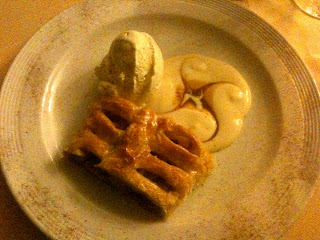Strudel or Streusel? Is this the most important question of our time? Probably. What's the difference? I'm glad you asked. Strudel is a dessert made of layers of thin sheets of pastry wrapped around a fruit filling (often apple), while Streusel is the sugary crumble topping found on some fruit pies or cakes (often cherry). While in Germany for a week, I envisioned a friendly face-off between these desserts. I would gamely try a number of each before announcing a tie, I thought. I was wrong. Field notes and the ultimate winner after the jump.
Apfelstrudel
(Apple Strudel)
Warm Apple Strudel, though traditionally Viennese, is also popular in Southern Germany, so it stands to reason that it should be all flaky and awesome and everywhere, like croissants in Paris, yes? This, sadly, was not my experience. While it was everywhere, it was a disappointment most places. I had to be thorough though, so LCBF and I tried it at four different places--three in Heidelberg and one at the Frankfurt airport.
The saddest strudel was this one from Kamps (a chain bakery store):
In fairness, this was a take-away strudel and we ate it cold because we had no microwave, but it tasted like, well, toaster strudel.
In third place was this strudel from the Kurpfälzisches Museum Restaurant (more on our meal here to come in another post):
It was warm and the ice cream was tasty, but the pastry was gummy rather than flaky. Ultimately unimpressive.
We did have a pretty tasty strudel at Cafe Romantic (Hauptstrasse 165, Heidelberg), which was kind of a dive. The interior looked a little bit like a German-themed motel lobby circa 1983 and we had the place to ourselves in the middle of the afternoon (perhaps that was the romantic part?).
The strudel was pretty good though--the layers were nice and delicate:
But the best strudel of all, however, was actually at Käfer's Bistro at the Frankfurt airport. This was also where we had our best German fare of the week. We couldn't decide whether the place was a surprisingly good airport restaurant or the restaurants in Heidelberg are surprisingly mediocre (probably a little of both--but that's another post). In any event, this strudel was the only one I'd call great. Nice and flaky, and tasted like it was made in-house. Mmmm . . .
Even the best of the apfulstrudels, however, was no match for the various cherry streusel tarts and kuchens (cakes) I tried.
Cherry Streusel
The first cherry streusel I tried was actually at the little cafe in the Heidelberg Castle, next to the giant tun, and it was far yummier than any historical monument concession counter dessert had any right to be. I somehow forgot to take a picture of the streusel, so here's a pic from inside the castle. Note the turnip in its mouth, which indicates the fate of vegetarians in centuries past: they were wall-mounted.
My second favorite streusel was at Käfer's Bistro, and yes, we did have both apfulstrudel and cherry streusel (and black forest cake) at Käfer's. It was a long day at the Frankfurt airport.
This streusel was delicious and very sweet in comparison to my all time favorite . . . the sour cherry streuselkuchen at Cafe Burkardt in Heidelberg (Untere Strasse 27).
The combination of the tart sour cherries with the sweet cake and crust was amazing. LCBF had the "student cake" (on the right), which was a cheesecake with various fruits. I really liked this place. The interior was warm, cozy, and very comfortable. I liked it so much in fact that we came back a couple days later for another round:
I had this Viennese walnut cake, which was fantastic, and LCBF had this carrot cake:
His carrot cake was good, but nothing really special like the other ones. Ah well, 3 out of 4 is pretty good.
The ULTIMATE WINNER is . . . Sour Cherry Streusel by a mile!
And now you know.












Ummm..... more than one dish is known as strudel. One is filled, and then rolled. In the other, an unsugared fairly soft dough generally made of eggs, water, and flour - sometimes milk - is rolled as thin as possible, ideally you could read through it. It is then rolled, and the roll cut into two inch lengths.
ReplyDeleteThese are served with fried potatoes; the potatoes are fried, and then enough water to cover is added and brought to a boil. The cut pieces of roll - the "noodles" - are placed on top and the pot covered tightly. Allow to boil without removing the lid for thirty minutes or they will become tough.
When the water is gone, you will hear frying, at that point you may remove the cover and gently mix, letting the noodles brown a bit.
Delicious. Other foods than potatoes may be used.
This recipe was popular among the Germans from Russia; some of my paternal ancestors came from Bessarabia and brought this tradition with them.
The North Dakota State University sells Germans from Russia cultural books, including cookbooks, as part of the support for the Germans from Russia Heritage Collection. They may be purchased at www.ndsu.edu/grhc/order.
There are many recipes in these that are adaptable to vegetarian cuisine as there are many good substitutes for lard and many dishes involved no meat, only eggs and dairy.